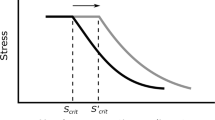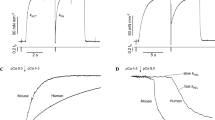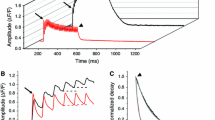Abstract
We set out to determine the factors responsible for twitch force decline in isolated intact rat cardiac trabeculae. The contractile force of trabeculae declined over extended periods of isometric twitch contractions. The force-frequency relationship within the frequency range of 4–8 Hz, at 37 °C, became more positive and the frequency optimum shifted to higher rates with this decline in baseline twitch tensions. The post-rest potentiation (37 °C), a phenomenon highly dependent on calcium handling mechanisms, became more pronounced with decrease in twitch tensions. We show that the main abnormality during muscle run-down was not due to a deficit in the myofilaments; maximal tension achieved using a K+ contracture protocol was either unaffected or only slightly decreased. Conversely, the sarcoplasmic reticulum (SR) calcium content, as assessed by rapid cooling contractures (from 27 to 0 °C), decreased, and had a close association with the declining twitch tensions (R2 ~ 0.76). SR Ca2+-ATPase, relative to Na+/Ca2+ exchanger activity, was not altered as there was no significant change in paired rapid cooling contracture ratios. Furthermore, confocal microscopy detected no abnormalities in the overall structure of the cardiomyocytes and t-tubules in the cardiac trabeculae (~23 °C). Overall, the data indicates that the primary mechanism responsible for force run-down in multi-cellular cardiac preparations is a decline in the SR calcium content and not the maximal tension generation capability of the myofilaments.





Similar content being viewed by others
References
Backx PH, Ter Keurs HE (1993) Fluorescent properties of rat cardiac trabeculae microinjected with fura-2 salt. Am J Physiol Heart Circ Physiol 264:H1098–H1110
Bassani JW, Bassani RA, Bers DM (1994) Relaxation in rabbit and rat cardiac cells: species-dependent differences in cellular mechanisms. J Physiol 476:279–293
Bers DM (1989) SR Ca loading in cardiac muscle preparations based on rapid-cooling contractures. Am J Physiol 256:C109–C120
Bers DM (2001) Excitation-contraction coupling and cardiac contractile force. Kluwer Academic Publishers, Dordrecht
Bers DM (2002) Cardiac excitation–contraction coupling. Nature 415:198–205
Bers DM, Bassani RA, Bassani JW, Baudet S, Hryshko LV (1993) Paradoxical twitch potentiation after rest in cardiac muscle: increased fractional release of SR calcium. J Mol Cell Cardiol 25:1047–1057
Biesiadecki BJ, Davis JP, Ziolo MT, Janssen PML (2014) Tri-modal regulation of cardiac muscle relaxation; intracellular calcium decline, thin filament deactivation, and cross-bridge cycling kinetics. Biophys Rev. doi:10.1007/s12551-014-0143-5
Brunello L et al (2013) Decreased RyR2 refractoriness determines myocardial synchronization of aberrant Ca2+ release in a genetic model of arrhythmia. Proc Natl Acad Sci USA 110:10312–10317
Bupha-Intr T, Haizlip KM, Janssen PM (2009) Temporal changes in expression of connexin 43 after load-induced hypertrophy in vitro. Am J Physiol Heart Circ Physiol 296:H806–H814
de Tombe PP, Little WC (1994) Inotropic effects of ejection are myocardial properties. Am J Physiol Heart Circ Physiol 266:H1202–H1213
Endoh M (2004) Force-frequency relationship in intact mammalian ventricular myocardium: physiological and pathophysiological relevance. Eur J Pharmacol 500:73–86
Hasenfuss G, Pieske B (2002) Calcium cycling in congestive heart failure. J Mol Cell Cardiol 34:951–969
Hasenfuss G et al (1994) Relation between myocardial function and expression of sarcoplasmic reticulum Ca(2+)-ATPase in failing and nonfailing human myocardium. Circ Res 75:434–442
Hiranandani N, Varian KD, Monasky MM, Janssen PM (2006) Frequency-dependent contractile response of isolated cardiac trabeculae under hypo-, normo-, and hyperthermic conditions. J Appl Physiol 100:1727–1732
Janssen PML (2010a) 54th Bowditch Lecture: myocardial contraction-relaxation coupling. Am J Physiol Heart Circ Physiol 299:H1741–H1749. doi:10.1152/ajpheart.00759.2010
Janssen PML (2010b) Kinetics of cardiac muscle contraction and relaxation are linked and determined by properties of the cardiac sarcomere. Am J Physiol Heart Circ Physiol 299:H1092–H1099
Janssen PML, Periasamy M (2007) Determinants of frequency-dependent contraction and relaxation of mammalian myocardium. J Mol Cell Cardiol 43:523–531
Janssen PML, Lehnart SE, Prestle J, Lynker JC, Salfeld P, Just H, Hasenfuss G (1998) The trabecula culture system: a novel technique to study contractile parameters over a multiday time period. Am J Physiol Heart Circ Physiol 274:H1481–H1488
Janssen PML, Lehnart SE, Prestle J, Hasenfuss G (1999) Preservation of contractile characteristics of human myocardium in multi-day cell culture. J Mol Cell Cardiol 31:1419–1427
Layland J, Kentish JC (1999) Positive force- and [Ca2+]i-frequency relationships in rat ventricular trabeculae at physiological frequencies. Am J Physiol Heart Circ Physiol 276:H9–H18
Maier LS, Brandes R, Pieske B, Bers DM (1998) Effects of left ventricular hypertrophy on force and Ca2+ handling in isolated rat myocardium. Am J Physiol 274:H1361–H1370
Maier LS, Bers DM, Pieske B (2000) Differences in Ca(2+)-handling and sarcoplasmic reticulum Ca(2+)-content in isolated rat and rabbit myocardium. J Mol Cell Cardiol 32:2249–2258
Milani-Nejad N, Janssen PM (2014) Small and large animal models in cardiac contraction research: advantages and disadvantages. Pharmacol Ther 141:235–249
Milani-Nejad N, Xu Y, Davis JP, Campbell KS, Janssen PM (2013) Effect of muscle length on cross-bridge kinetics in intact cardiac trabeculae at body temperature. J Gen Physiol 141:133–139
Monasky MM, Janssen PML (2009) The positive force-frequency relationship is maintained in absence of sarcoplasmic reticulum function in rabbit, but not in rat myocardium. J Comp Physiol B 179:469–479
Monasky MM, Varian KD, Janssen PML (2008) Gender comparison of contractile performance and beta-adrenergic response in isolated rat cardiac trabeculae. J Comp Physiol B 178:307–313
Pieske B, Maier LS, Bers DM, Hasenfuss G (1999) Ca2+ handling and sarcoplasmic reticulum Ca2+ content in isolated failing and nonfailing human myocardium. Circ Res 85:38–46
Raman S, Kelley MA, Janssen PML (2006) Effect of muscle dimensions on trabecular contractile performance under physiological conditions. Pflugers Arch 451:625–630
Schouten VJ, ter Keurs HE (1986) The force-frequency relationship in rat myocardium. The influence of muscle dimensions. Pflugers Arch 407:14–17
Stull LB, Leppo M, Marban E, Janssen PML (2002) Physiological determinants of contractile force generation and calcium handling in mouse myocardium. J Mol Cell Cardiol 34:1367–1376
Taylor DG, Parilak LD, LeWinter MM, Knot HJ (2004) Quantification of the rat left ventricle force and Ca2+-frequency relationships: similarities to dog and human. Cardiovasc Res 61:77–86
Varian KD, Xu Y, Torres CA, Monasky MM, Janssen PML (2009) A random cycle length approach for assessment of myocardial contraction in isolated rabbit myocardium. Am J Physiol Heart Circ Physiol 297:H1940–H1948
Acknowledgments
This study was supported by NIH RO1 HL113084 to P.M.L.J. and American Heart Association Greater Rivers Affiliate Predoctoral Fellowship Award 1148008 to N.M.
Author information
Authors and Affiliations
Corresponding author
Rights and permissions
About this article
Cite this article
Milani-Nejad, N., Brunello, L., Gyorke, S. et al. Decrease in sarcoplasmic reticulum calcium content, not myofilament function, contributes to muscle twitch force decline in isolated cardiac trabeculae. J Muscle Res Cell Motil 35, 225–234 (2014). https://doi.org/10.1007/s10974-014-9386-9
Received:
Accepted:
Published:
Issue Date:
DOI: https://doi.org/10.1007/s10974-014-9386-9




